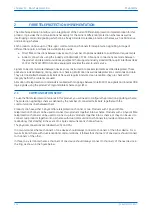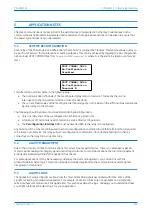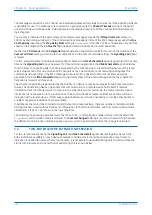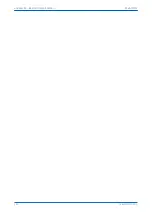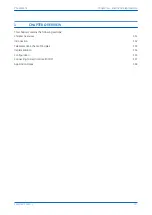
The messages received on each channel are individually assessed for quality to ensure the IM64 signalling scheme
is available for use. If no messages are received for a period equal to the Channel Timeout setting or the signal
quality falls below a defined value, DDB signals are activated as shown in the IM64 channel fail and scheme fail
logic diagram.
Poor quality is indicated if the percentage of incomplete messages exceeds the IM Msg Alarm Lvl setting in a
100 ms period (rolling window), or if the communications propagation time of the IM64 message exceeds the Max
Ch PropDelay (assuming the Prop Delay Stats setting is
Enabled
), or if (in IEEE C37.94 configuration only, and not
shown on the diagram) the Ch Mux Clk flag has been raised to indicate an incorrect baud rate.
If either the Ch Timeout or the Ch Degraded signal persists in the alarmed state for more than the duration of the
Comm Fail Timer setting, according to the conditions set in the Comm Fail Mode setting, the Signalling Fail signal
is raised.
For two-ended schemes (including dual redundant schemes), the IM64 SchemeFail signal is generated at the same
time as the Signalling Fail signal. However, for three-terminal applications, the IM64 SchemeFail signal indicates
that the full set of signalling bits cannot be processed by the scheme. Due to the self-healing nature of the three-
terminal application, this occurs when both channels at any one terminal are not receiving valid signals. This
condition generates a flag in the IM64 message structure which is passed to both remote ends, as well as
generating the local IM64 SchemeFail signal. Using this method, in three-terminal applications the scheme fail
indication is raised at all three ends.
The scheme fail signalling is generated by the inability of a device to receive messages through communication
failure. The transmitting device only knows that communication to a remote device has failed if it receives
notification from the remote device. If a device in the scheme is put into test mode, the communication failure
information is not passed on to the remote ends. If the communications failure is bidirectional, there will be no
indication at the remote device. If this causes operational issues, it may be necessary to include other signals to
enable more precise indication of scheme failure.
In addition to the main IM64 channel fail and scheme fail conceptual logic, there are number of additional alarm
DDB signals associated with test modes, reconfiguration for 3-terminal schemes, and the communication mode
(‘Standard’ or ‘IEEE C37.94’) shown in the logic diagrams.
The majority of signals are associated with the ‘IEEE C37.94’ communications mode and are not activated if the
Standard
communication mode is selected. The Comms Changed DDB logic is to show that switching between
the different communication modes requires a power cycle to be performed before the change is activated.
5.4
TWO-ENDED SCHEME EXTENDED SUPERVISION
For two-terminal applications, the Signalling Fail and IM64 SchemeFail signals operate together. As such, the
basic indications available on each device should be considered as local-terminal indications only. If remote
indication is needed to assure scheme functionality, it is necessary to use additional signals to communicate the
status to the remote end. One method of performing this is shown below:
Chapter 15 - Fibre Teleprotection
P54A/B/C/E
326
P54xMED-TM-EN-1
Summary of Contents for P4A
Page 2: ......
Page 20: ...Contents P54A B C E xviii P54xMED TM EN 1 ...
Page 27: ...CHAPTER 1 INTRODUCTION ...
Page 28: ...Chapter 1 Introduction P54A B C E 2 P54xMED TM EN 1 ...
Page 38: ...Chapter 1 Introduction P54A B C E 12 P54xMED TM EN 1 ...
Page 39: ...CHAPTER 2 SAFETY INFORMATION ...
Page 40: ...Chapter 2 Safety Information P54A B C E 14 P54xMED TM EN 1 ...
Page 52: ...Chapter 2 Safety Information P54A B C E 26 P54xMED TM EN 1 ...
Page 53: ...CHAPTER 3 HARDWARE DESIGN ...
Page 54: ...Chapter 3 Hardware Design P54A B C E 28 P54xMED TM EN 1 ...
Page 86: ...Chapter 3 Hardware Design P54A B C E 60 P54xMED TM EN 1 ...
Page 87: ...CHAPTER 4 SOFTWARE DESIGN ...
Page 88: ...Chapter 4 Software Design P54A B C E 62 P54xMED TM EN 1 ...
Page 99: ...CHAPTER 5 CONFIGURATION ...
Page 100: ...Chapter 5 Configuration P54A B C E 74 P54xMED TM EN 1 ...
Page 120: ...Chapter 5 Configuration P54A B C E 94 P54xMED TM EN 1 ...
Page 121: ...CHAPTER 6 CURRENT DIFFERENTIAL PROTECTION ...
Page 122: ...Chapter 6 Current Differential Protection P54A B C E 96 P54xMED TM EN 1 ...
Page 149: ...CHAPTER 7 AUTORECLOSE ...
Page 150: ...Chapter 7 Autoreclose P54A B C E 124 P54xMED TM EN 1 ...
Page 207: ...CHAPTER 8 CB FAIL PROTECTION ...
Page 208: ...Chapter 8 CB Fail Protection P54A B C E 182 P54xMED TM EN 1 ...
Page 219: ...CHAPTER 9 CURRENT PROTECTION FUNCTIONS ...
Page 220: ...Chapter 9 Current Protection Functions P54A B C E 194 P54xMED TM EN 1 ...
Page 244: ...Chapter 9 Current Protection Functions P54A B C E 218 P54xMED TM EN 1 ...
Page 247: ...CHAPTER 10 VOLTAGE PROTECTION FUNCTIONS ...
Page 248: ...Chapter 10 Voltage Protection Functions P54A B C E 222 P54xMED TM EN 1 ...
Page 261: ...CHAPTER 11 FREQUENCY PROTECTION FUNCTIONS ...
Page 262: ...Chapter 11 Frequency Protection Functions P54A B C E 236 P54xMED TM EN 1 ...
Page 268: ...Chapter 11 Frequency Protection Functions P54A B C E 242 P54xMED TM EN 1 ...
Page 269: ...CHAPTER 12 MONITORING AND CONTROL ...
Page 270: ...Chapter 12 Monitoring and Control P54A B C E 244 P54xMED TM EN 1 ...
Page 300: ...Chapter 12 Monitoring and Control P54A B C E 274 P54xMED TM EN 1 ...
Page 301: ...CHAPTER 13 SUPERVISION ...
Page 302: ...Chapter 13 Supervision P54A B C E 276 P54xMED TM EN 1 ...
Page 312: ...Chapter 13 Supervision P54A B C E 286 P54xMED TM EN 1 ...
Page 323: ...CHAPTER 14 DIGITAL I O AND PSL CONFIGURATION ...
Page 324: ...Chapter 14 Digital I O and PSL Configuration P54A B C E 298 P54xMED TM EN 1 ...
Page 336: ...Chapter 14 Digital I O and PSL Configuration P54A B C E 310 P54xMED TM EN 1 ...
Page 337: ...CHAPTER 15 FIBRE TELEPROTECTION ...
Page 338: ...Chapter 15 Fibre Teleprotection P54A B C E 312 P54xMED TM EN 1 ...
Page 354: ...Chapter 15 Fibre Teleprotection P54A B C E 328 P54xMED TM EN 1 ...
Page 355: ...CHAPTER 16 ELECTRICAL TELEPROTECTION ...
Page 356: ...Chapter 16 Electrical Teleprotection P54A B C E 330 P54xMED TM EN 1 ...
Page 366: ...Chapter 16 Electrical Teleprotection P54A B C E 340 P54xMED TM EN 1 ...
Page 367: ...CHAPTER 17 COMMUNICATIONS ...
Page 368: ...Chapter 17 Communications P54A B C E 342 P54xMED TM EN 1 ...
Page 439: ...CHAPTER 18 CYBER SECURITY ...
Page 440: ...Chapter 18 Cyber Security P54A B C E 414 P54xMED TM EN 1 ...
Page 457: ...CHAPTER 19 INSTALLATION ...
Page 458: ...Chapter 19 Installation P54A B C E 432 P54xMED TM EN 1 ...
Page 471: ...CHAPTER 20 COMMISSIONING INSTRUCTIONS ...
Page 472: ...Chapter 20 Commissioning Instructions P54A B C E 446 P54xMED TM EN 1 ...
Page 513: ...CHAPTER 21 MAINTENANCE AND TROUBLESHOOTING ...
Page 514: ...Chapter 21 Maintenance and Troubleshooting P54A B C E 488 P54xMED TM EN 1 ...
Page 530: ...Chapter 21 Maintenance and Troubleshooting P54A B C E 504 P54xMED TM EN 1 ...
Page 531: ...CHAPTER 22 TECHNICAL SPECIFICATIONS ...
Page 532: ...Chapter 22 Technical Specifications P54A B C E 506 P54xMED TM EN 1 ...
Page 558: ...Chapter 22 Technical Specifications P54A B C E 532 P54xMED TM EN 1 ...
Page 559: ...APPENDIX A ORDERING OPTIONS ...
Page 560: ...Appendix A Ordering Options P54A B C E P54xMED TM EN 1 ...
Page 565: ...APPENDIX B SETTINGS AND SIGNALS ...
Page 566: ...Appendix B Settings and Signals P54A B C E P54xMED TM EN 1 ...
Page 790: ...Appendix B Settings and Signals P54A B C E B224 P54xMED TM EN 1 ...
Page 835: ...APPENDIX C WIRING DIAGRAMS ...
Page 836: ...Appendix C Wiring Diagrams P54A B C E P54xMED TM EN 1 ...
Page 849: ......



